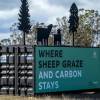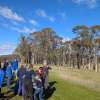
Dougal Morrison shares carbon, tree farming insights at Red Meat Updates
Posted 29 July 2025
Plantation planning On-farm benefits Economic benefits and markets Carbon benefits PFT
Private Forests Tasmania was front and centre at one of the state's largest gatherings of red meat producers last week.
PFT sponsored a Primary Session at the 2025 Red Meat Updates conference at the Tailrace Centre, Riverside, with the theme: “The influence of change on cost of production in red meat businesses.”
The session was chaired by PFT CEO Dr Elizabeth Pietrzykowski and featured a thought-provoking discussion facilitated by Felicity Richards and included insights from farmers James Knight (Sisters Pastoral), Georgie Burbury (Burbury Ag), and Midlands farmer and PFT Stems for CO₂ project grant recipient Dougal Morrison.
Dougal, a fifth-generation farmer from St Peters Pass, shared his family’s experience integrating forestry into their farming enterprise — a decision driven by careful analysis and long-term thinking.
Following the harvest of a former Gunns eucalyptus nitens plantation, the family assessed their options: convert the land to pasture or replant with trees.
They decided to establish Pinus radiata plantations, recognising the species' suitability to Tasmania’s Midlands climate and soil conditions.
"The land wasn’t ideal for pasture," Dougal said.
"We weighed up the economics and decided replanting and claiming carbon credits made more sense — especially with support from two Private Forests Tasmania grants [a round 2 Integrated Farm Forestry grant and the Stems for CO₂ grant]."
The new plantings will support both carbon sequestration and future timber production — and more importantly, Dougal said, contribute to a succession-ready farm for the next generation at St Peters Pass.
With 405 hectares of plantation and 30–40% of the property retained as native forest, the family applies a “right tree, right place” approach, using marginal land that’s not viable for grazing or cropping.
Dougal was candid about the learning curve.
“I’m not a forester,” he said.
“I’d strongly encourage anyone looking to plant or manage trees to get professional advice — on everything from species selection and planting to carbon and long-term management. PFT is a great place to start if you want pre-commercial guidance.”
He also pointed to research showing the broader benefits of integrating trees into farming systems — from improving lamb survivability and pasture growth to enhancing water retention and providing shade and shelter for livestock.
But his message was clear: “Don’t rush in. Understand your goals and work with a forestry consultant to plan properly".
For Dougal and his family, trees on underperforming land aren't just an environmental investment — they’re a strategic, economic decision that aligns with long-term, whole-farm planning.
Share this Article
Latest Articles
-

17 September 2025
Celebrating excellence at the Tasmanian Timber Awards
-

17 September 2025
Forest Practices Authority Research Update Day
-

13 August 2025
Have you seen our Stems for CO2 Project signage on the Midlands Highway?
Archives
- ActivAcre hits milestone, calls for more farmers to get on board
- Napier's leading the way in sustainable forestry and carbon-neutral farming
- Sound science needed to assess carbon impacts of timber harvesting
- Newly appointed TFFPN Board of Directors
- Graduate Certificate of Forestry Scholarship
- Forestry Australia Mentoring Program 2025
- Forest Industry Roundtable planning for the long term
- Eagle Management Constraint Period extended
- Successful private native forest management celebrated
- $15 million investment in new ship loader to boost Bell Bay's forestry exports
- Standing with Tasmania's forestry industry: buy local
- TFPA: Tasmanian Freight Equalisation Scheme needs a ground-up review
- AFCA Gala Dinner celebrates industry excellence
- Fire permits now required Statewide
- Forest leaders hone skills in sustainable native regrowth management
- Tasmanian forests and the carbon market: Barriers and opportunities
- Spring is the time for fuel reduction burning
- Primed for Growth: A situation analysis of the Tasmanian Forest and Wood Products Sector
- Audit requirements cut for low-risk plantation projects
- Guidance and support for landowners after damaging winds
- Forestry Australia welcomes further definition of active forest management
- Farm & Forest Mapper Tool highlighted at Rural Youth Tasmania's Young Farmer of the Year competition
- Senate Select Committee inquiry into the Tasmanian Freight Equalisation Scheme
- Timberlink announces new wood composite products brand
- Newly developed protocol a vital tool for safeguarding forestry industry
- Red Hot Tips: Fire management for Tassie farmers
- Bioenergy: Fuelling industries with trees
- Harvesting trees: What you need to know
- Shelterbelts: How are they contributing to farm systems?
- Infill plantings and remnant vegetation: Why biodiversity depends on a thriving understory
- Plantation planning: The key to a successful plantation
- Exciting interactive forestry knowledge hub launched
- $450,000 farm forestry grant recipients revealed



